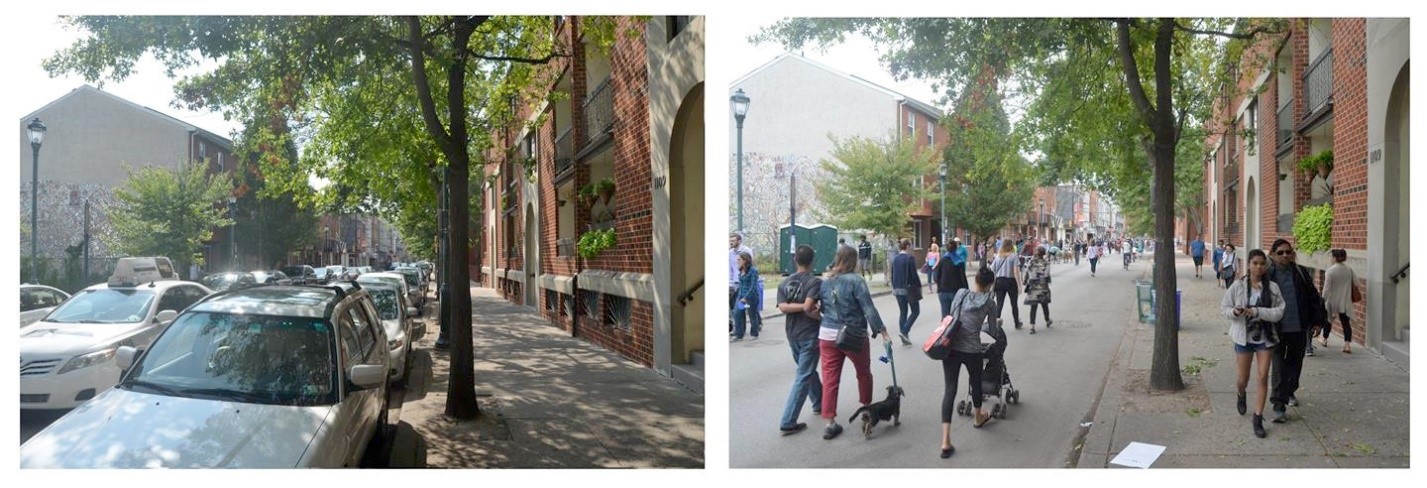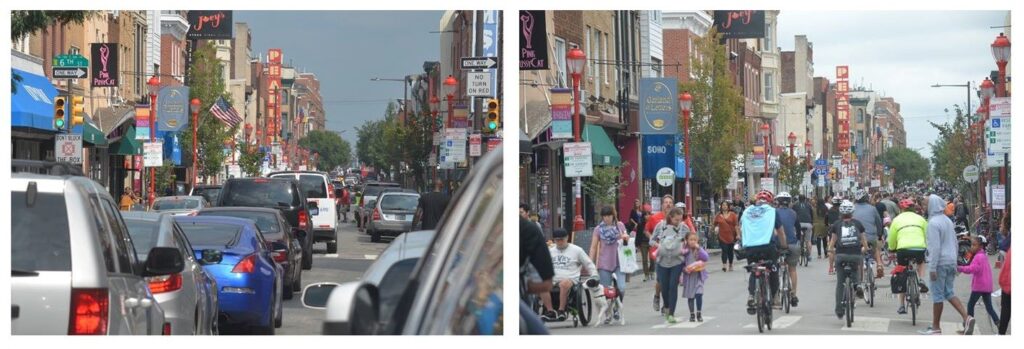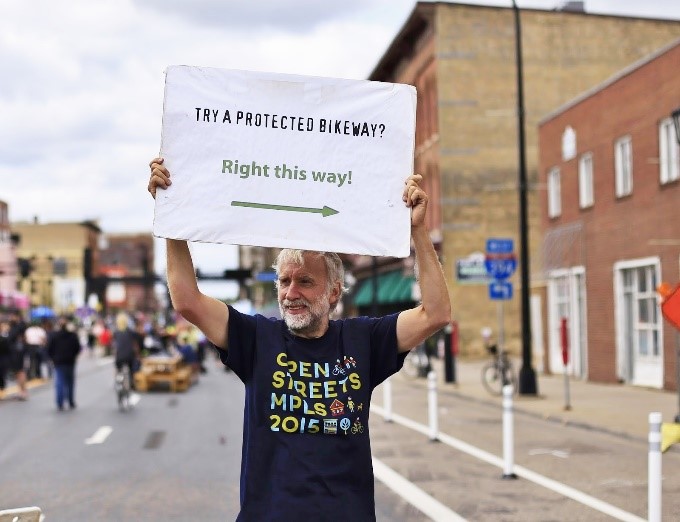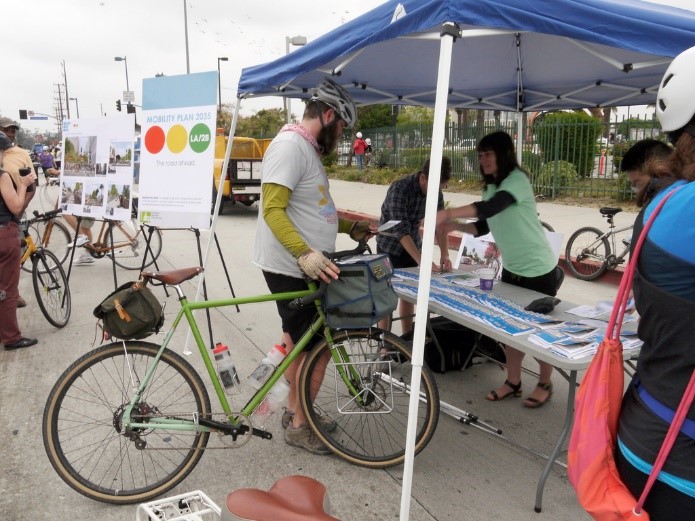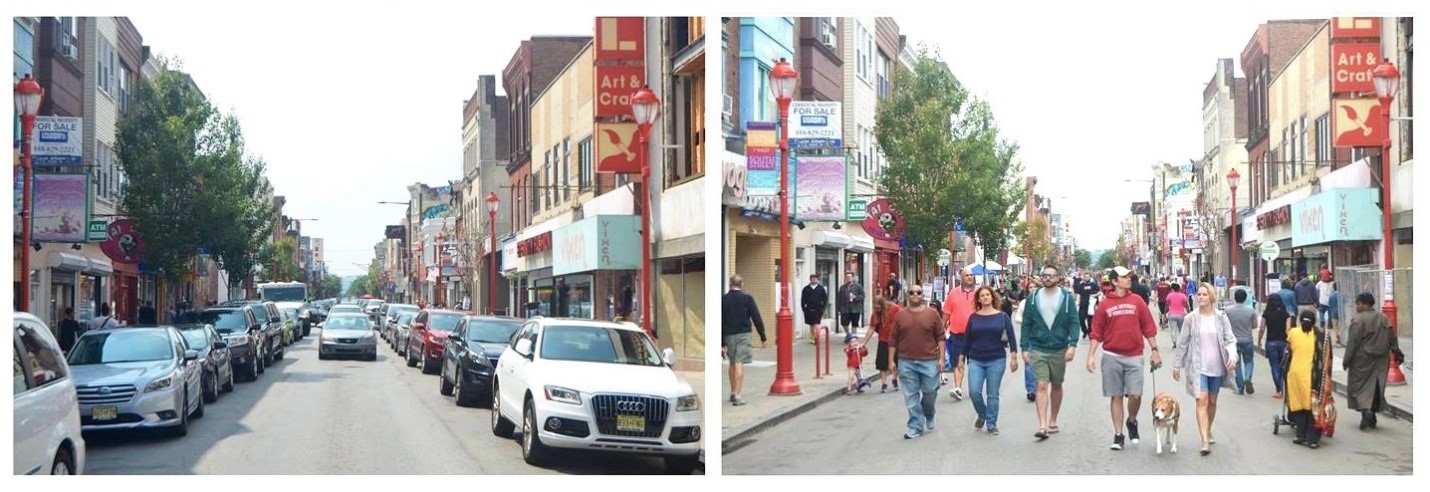 by Daniel Paschall
by Daniel Paschall
Which of the two images above shows a public space? Technically both. But they are two very different approaches to what makes a public space, and they beg larger questions for all cities. Which public space is more inviting? Which one looks like a place for all people? Which public space gives more back to its city?
The images show Philadelphia’s South Street, a vibrant mix of shops, restaurants, and residences at the border of Center City’s hustle and bustle and the tightly packed rowhouse neighborhoods of South Philly.
On the left: South Street on a typical Saturday. Although the street looks physically crowded, it is hard to see how many people are actually present, because the entire streetscape is taken up by parked cars or kept clear for those driving in cars.
On the right: South Street on an exceptional Saturday, September 24, during Philadelphia’s first open streets event, Philly Free Streets. As people walking five abreast illustrate, the street is full of life. And yet there are no visible street vendors or food stands, like at Philadelphia’s Night Markets, the typical city approach to draw pedestrian crowds. The people are not holding protest signs, nor are they dressed in costumes as part of a parade. They are simply walking down the street, in the middle of the street. That is the power of open streets.
Open Streets are Public Spaces Brought to Life
What is the purpose of an open streets event? At first glance, walking down a street might seem redundant. After all, most urban streets have sidewalks. But prioritizing street space for people-powered movement speaks to a much deeper purpose than simply changing the use of a street. When people walk, they exercise without thinking about it, become less stressed, and add years to their lives. When people walk in the street without fear of getting hit by a car, they open up their minds to their surroundings: family, friends, and neighbors walking around them; flowers and trees they’ve never noticed before; or the history embedded in building architecture, all of which glides by at an easy pace.
On foot, people can pause at any moment without worrying about parking (or double-parking). They can casually check out a shop or glance at a restaurant menu. Taking a moment to make a call, text a friend, or look something up online no longer becomes a life-threatening choice when made at an open streets event. Without car exhaust, the air will be cleaner to breathe. Without honking horns, conversations and laughter will be more pleasant to hear. Infuse an open streets event with activity and cultural programs, and suddenly people will be invited to dance, jump rope, create art, play music, or simply sit back and watch it all unfold. There is near unlimited potential in the streets that is unlocked simply by putting people first.
Growing Momentum to Take Back the Narrative of the Streets
Philly Free Streets was Philadelphia’s first open streets event, which took over South Street and extended up along the Schuylkill River to Fairmount Park for nearly ten miles. In doing so, Philadelphia joined in a growing movement of over one hundred cities and towns around the world.
For example, New York City’s Summer Streets shuts down Park Avenue in Manhattan for tens of thousands of participants a few times every August. Recently, Nairobi, Kenya and Pune, India have hosted open street events. Los Angeles hosts CicLAvia periodically throughout the year for over one hundred thousand people and across a wide variety of neighborhoods. In Guadalajara, Mexico, Vía RecreActiva gives arterial streets over to nearly two hundred thousand every Sunday, and Santiago, Chile, opens up an entire network of streets during CicloRecreoVía to about four hundred thousand every Sunday. Finally, the mother of all open streets events is held in Bogotá, which started in 1974 and has grown into the 80-mile-long Ciclovía, in which over one million people take to the streets every Sunday and holiday throughout the year.
Although these events are only temporary in nature, they are essential to rewriting the narrative of the street. Open streets are an intervention in the face of a city’s addiction to cars and a real-time chance to experience the argument in favor of streets as truly public spaces. As more cities host open streets at increasing frequencies, more people will be exposed to a new way of experiencing their city. Soon enough, the once-radical idea of people-prioritized streets takes on a mainstream reputation. Simultaneously, the century-old narrative that streets are for cars alone starts to fall apart.
Above all, open streets events let people live briefly in an alternate reality where their city prioritizes streets for people. This alternate reality challenges what people experience in their daily life, and argues that streets where people come first are not only possible but better than the current reality.
Connect Temporary Changes to Permanent Transformations
This new outlook can be accelerated beyond temporary events by advocating for a wide variety of small, incremental changes that share the same DNA as open streets. Examples include converting under-used or dangerous road space into space for public plazas, widened sidewalks, protected intersections, and protected bike lanes. When proposed as a demonstration or on a pilot basis, these incremental projects are much quicker, more cost-effective, and above all, more acceptable to the public than the often expensive and controversial capital projects that takes years or even decades to construct – often with unintended consequences only apparent after completion.
Open streets events can work in tandem with these pop-up and pilot projects by highlighting the changes during an event that educates participants or even connects them along the route of the event to a pop-up. In Minneapolis, Open Streets MPLS seized the opportunity of their event to connect cyclists to pop-up interventions such as protected intersections and protected bike lanes along the route. Afterwards, organizers collected feedback from participants.
Applying this strategy to a long-term scale, the content and projects highlighted by open streets events can tie into a comprehensive plan. This is starting to be the case in cities like Los Angeles, where CicLAvia links up with the city’s Mobility Plan 2035, passed early this year. CicLAvia routes are designed for streets that have been targeted for improved biking and walking infrastructure, which ultimately reinforces a larger network for active transport. By connecting the ephemeral yet mentally impactful open streets events with less press-worthy but more substantial short-to-long-term citywide efforts, cities can be more intentional about transforming their streets by strategies far greater than the sum of their parts.

